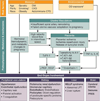Advances in the pathophysiology of pre-eclampsia and related podocyte injury
- PMID: 24573315
- PMCID: PMC4117806
- DOI: 10.1038/ki.2014.17
Advances in the pathophysiology of pre-eclampsia and related podocyte injury
Abstract
Pre-eclampsia is a pregnancy-specific hypertensive disorder that may lead to serious maternal and fetal complications. It is a multisystem disease that is commonly, but not always, accompanied by proteinuria. Its cause(s) remain unknown, and delivery remains the only definitive treatment. It is increasingly recognized that many pathophysiological processes contribute to this syndrome, with different signaling pathways converging at the point of systemic endothelial dysfunction, hypertension, and proteinuria. Different animal models of pre-eclampsia have proven utility for specific aspects of pre-eclampsia research, and offer insights into pathophysiology and treatment possibilities. Therapeutic interventions that specifically target these pathways may optimize pre-eclampsia management and may improve fetal and maternal outcomes. In addition, recent findings regarding placental, endothelial, and podocyte pathophysiology in pre-eclampsia provide unique and exciting possibilities for improved diagnostic accuracy. Emerging evidence suggests that testing for urinary podocytes or their markers may facilitate the prediction and diagnosis of pre-eclampsia. In this review, we explore recent research regarding placental, endothelial, and podocyte pathophysiology. We further discuss new signaling and genetic pathways that may contribute to pre-eclampsia pathophysiology, emerging screening and diagnostic strategies, and potential targeted interventions.
Conflict of interest statement
All other authors report no conflict of interest.
Figures



References
-
- World Health Organization. Geneva: WHO; [Accessed June 15, 2013]. The World Health Report 2005 - Make Every Mother and Child Count. http://www.who.int/whr/2005/en/.
-
- Raymond D, Peterson E. A critical review of early-onset and late-onset preeclampsia. Obstet Gynecol Surv. 2011;66:497–506. - PubMed
-
- Report of the National High Blood Pressure Education Program Working Group on High Blood Pressure in Pregnancy. Am J Obstet Gynecol. 2000;183:S1–S22. [No authors listed]. - PubMed
Publication types
MeSH terms
Substances
Grants and funding
LinkOut - more resources
Full Text Sources
Other Literature Sources

